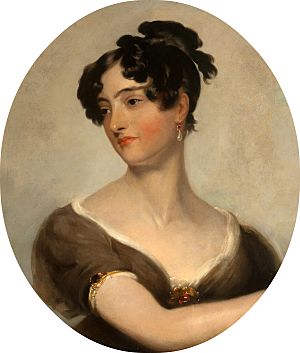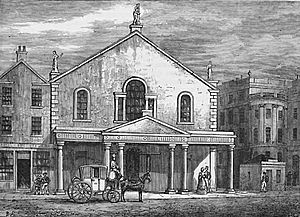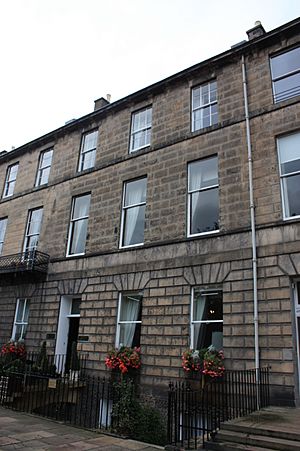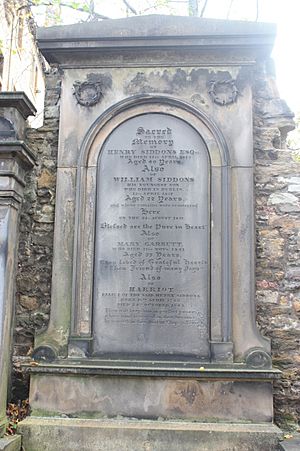Harriet Siddons facts for kids
Harriet Siddons (born Harriet Murray; 16 April 1783 – 2 November 1844) was a famous Scottish actress and theatre manager. People in Edinburgh often called her "Our Mrs Siddons." This helped tell her apart from her mother-in-law, Sarah Siddons, who was also a very famous English actress.
Contents
Harriet Siddons: A Life on Stage
Harriet Murray was born in Norwich, England, on 16 April 1783. Her father, Charles Murray, was also an actor.
Early Acting Career
Harriet started acting when she was very young.
- On 1 July 1793, she appeared in Bath as Prince Arthur.
- Her first show in London was at the Covent Garden Theatre on 12 May 1798. She played Perdita in a play called The Winter's Tale.
In 1801, she met Henry Siddons at Covent Garden. They acted together and got married the next year. They stayed at Covent Garden until 1805. Then, they both joined the Drury Lane Theatre Company. Harriet played many different roles, like Rosalind, Juliet, and Lady Teazle.
Moving to Edinburgh
In 1809, Harriet and Henry moved to Edinburgh, Scotland. They took over the Theatre Royal on Princes Street. Harriet helped her husband manage the theatre and also acted alongside him. Her first role in Edinburgh was on 9 November 1809, playing Juliana in "The Honey Moon".
They lived in Edinburgh, first at 3 Maitland Street and then at 3 Forth Street.
Managing the Theatre Royal
In 1814, Harriet was offered a big role in London, but she chose to stay in Edinburgh. When Henry Siddons died in 1815, the Theatre Royal was having money problems. But Harriet, with her brother William Henry Murray, worked hard to fix things. She managed the theatre for 21 years.
A very important moment for the theatre was the play Rob Roy, which opened on 15 February 1819. It became a huge success. When King George IV visited Scotland, Rob Roy was performed for him. Harriet Siddons played Diana Vernon for that special night.
Sir Walter Scott, a famous Scottish writer, was a close friend of Harriet. He wrote many stories and plays especially for the theatre.
In 1827, Mrs. Siddons moved to 23 Windsor Street in Edinburgh. This beautiful house was designed by William Henry Playfair. It was only about a ten-minute walk from the theatre.
By 1830, Mrs. Siddons had paid all her rental payments for the theatre. This meant she became the full owner of the Theatre Royal.
Retirement and Later Life
Harriet Siddons' last show was on 29 March 1830. Sir Walter Scott wrote a special speech for her to deliver that night. Her final role was Lady Townley in "The Provoked Husband".
After retiring, Mrs. Siddons continued to live in Edinburgh. She was a much-loved person in the city. People were very proud of her and kept calling her "Our Mrs Siddons."
In her final years, she moved to 29 Abercromby Place. This was a more central spot for social events.
Harriet Siddons died at her home on Abercromby Place on 2 November 1844. She was 61 years old. She is buried with her husband in Greyfriars Kirkyard in Edinburgh. Their grave is in the south-west corner of the churchyard.
Epilogue
After Harriet Siddons retired in 1830, her brother, William Henry Murray, took over the Theatre Royal. He managed it for 21 years, until 1851.
The theatre later moved to a new building on Broughton Street. The original Theatre Royal building was torn down in 1895. A new post office building was built there instead.
Today, the only thing left from the original theatre is a cast-iron post on the pavement. This is where people would tie up their horses outside the theatre.





